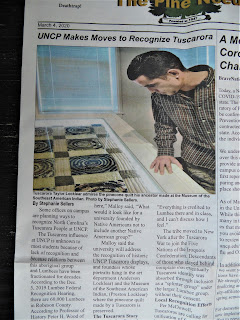The
Exsanguination of the Second Society: Scholarly Historical Fiction Relating to
Robeson County, North Carolina's Tuscaroras is a book within a book, set in
rural North Carolina in the year 2020. Each chapter has a shadow chapter, i.e.,
Chapter 1, The Vexing Now, Jake’s present life, is shadowed by Chapter 1,
The Vexing Then, Jake’s past life, which is a draft of a collaborated
book with a librarian written out of desperation. Psychohistory binds the
chapter versions while a love story propels the reader to learn if Jake Wilkes
“bakes an apple pie” for his proposal as a love triangle’s roots are exposed and
a tribe is threatened with extinction.
The Lumbee Tribe recently “shadowed
in” NC’s Tuscaroras as a “splinter tribe,” without their consent, thusly
oppressing their heritage and efforts for reparations.
This shadow-chapter method works to serve
as a demonstration of human behavior in how political decisions are made. It demonstrates
how time has changed the region’s culture thusly affecting perspectives during
adaptation periods while it also highlights what does not change. This method
highlights the region’s endangered vernacular as a social language that binds
community. During interviews, as people grew relaxed with me, both Lumbees and
Tuscaroras used more of the region’s vernacular.
Most importantly, it highlights the
endangerment of the factual history of NC’s Tuscaroras, early victims of
colonization in forced removal from their own lands. It draws attention to how
the People have been victimized by colonization’s limited scope of preservation,
by land swindlers, by political persuasion, and widespread bias and oppression,
much of which has been culminated from false narratives, ultimately fulfilling
the original white philosophy of “kill the Indian, save the man.”
Seventy-five annotated references are within the
body of the story. From an instructional aspect, the presentation of the facts
provokes curiosity in learners: It encourages research. The Then
chapters are designed to attract young readers and serves as a relief from the Now
chapters which are heavier with facts. The shadowing methods demonstrates how
behavior patterns within different eras transcend timelines.










No comments:
Post a Comment
Your comments are welcome!